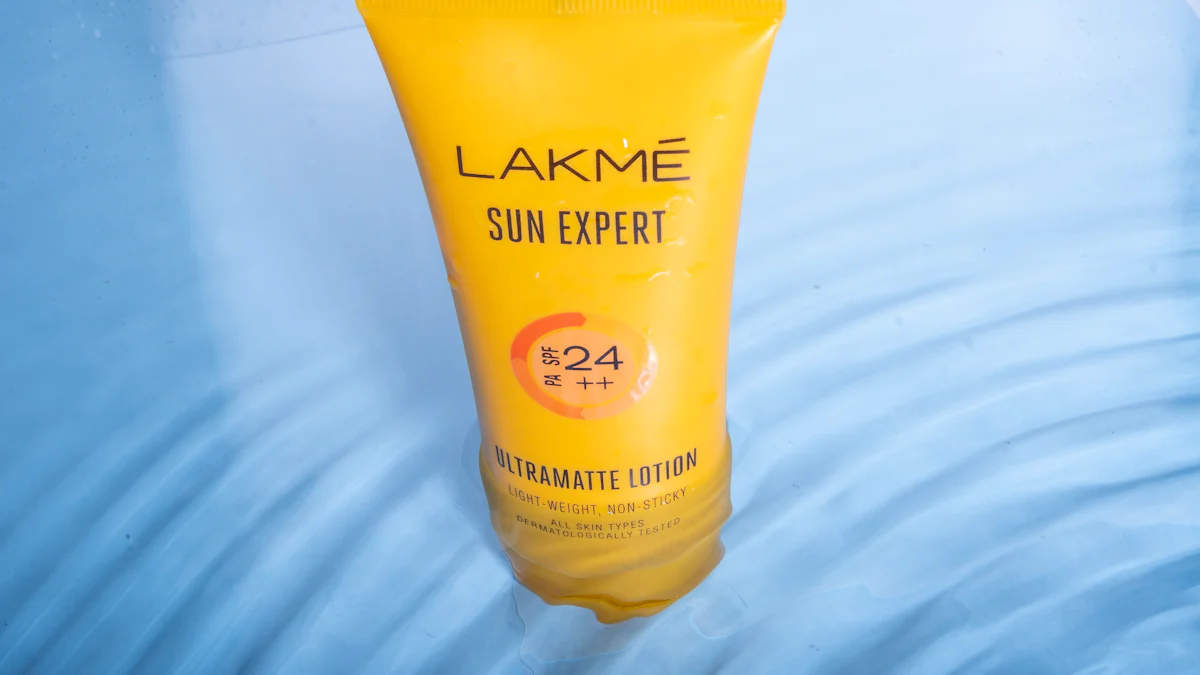Tinted Sunscreens vs Regular Sunscreens: Which Offers Better Protection?

Sunscreen plays a crucial role in protecting your skin from harmful UV rays. Many people reach for sunscreen only during summer, but experts recommend year-round use. You have two main options: Tinted Sunscreens and Regular Sunscreens. Tinted Sunscreens offer light coverage and help even out your complexion. Regular Sunscreens focus on blocking UV rays without additional color. Understanding the differences between these types can help you make an informed choice. Your skin deserves the best protection possible, so let's dive into what each option offers.
Understanding Sunscreen Protection
The Role of Sunscreens
Protection against UV Radiation
Sunscreens act as a shield against harmful UV radiation. UV rays can cause sunburn and increase the risk of skin cancer. Regular use of sunscreen helps prevent these effects. Both tinted and regular sunscreens offer this essential protection. Tinted sunscreens often contain iron oxides, which enhance UV protection.
Protection against Blue Light
Blue light comes from screens and the sun. It can lead to premature aging and dark spots. Tinted sunscreens provide an edge here. Ingredients like iron oxides in tinted sunscreens block blue light effectively. Regular sunscreens may not offer the same level of blue light protection. Choosing the right sunscreen depends on your exposure to screens and sunlight.
Importance of Broad-Spectrum Protection
UVA and UVB Rays
Broad-spectrum sunscreens protect against both UVA and UVB rays. UVA rays penetrate deeply, causing aging and wrinkles. UVB rays affect the skin's surface, leading to burns. Both types of sunscreens should offer broad-spectrum protection. This ensures comprehensive defense against sun damage.
Visible Light and Infrared Radiation
Visible light includes blue light, which affects skin health. Infrared radiation can also impact skin by causing heat damage. Tinted sunscreens often excel in blocking visible light due to their unique ingredients. Regular sunscreens focus more on UV protection. Consider your daily activities when selecting between tinted and regular options.
Tinted Sunscreens

Composition and Functionality
Ingredients in Tinted Sunscreens
Tinted sunscreens combine traditional sun-blocking agents with pigments like iron oxides. These pigments help even out your skin tone and combat the white cast often left by regular sunscreens. Products like EltaMD UV Restore Tinted Broad-Spectrum SPF 40 use these ingredients to provide protection against blue light. You get both UV defense and a smoother complexion.
How Tinted Sunscreens Work
Tinted sunscreens work by reflecting and absorbing harmful rays. The pigments in these products, such as those in Sheer Defense Tinted SPF 46, block UVA/UVB and infrared radiation. This dual action helps reduce redness and blotchiness. The fast-absorbing formula ensures a comfortable wear throughout the day.
Pros and Cons
Advantages of Tinted Sunscreens
Broad-Spectrum Protection: Tinted sunscreens like La Roche-Posay Anthelios Tinted Mineral Ultra Fluid SPF 50 offer comprehensive defense against various types of light.
Aesthetic Appeal: These products blend well with different skin tones, providing a natural finish.
Convenience: Tinted sunscreens serve as a two-in-one product, acting as both sunscreen and makeup base.
Skin Health: Regular use can enhance skin health over time, reducing the appearance of blemishes.
Disadvantages of Tinted Sunscreens
Limited Shades: Some products may not match all skin tones perfectly.
Potential for Clogging Pores: Heavier formulations might not suit oily skin types.
Price Point: Tinted options can be more expensive than regular sunscreens.
Application Tips
How to Apply Tinted Sunscreens
Apply tinted sunscreen generously to clean, dry skin. Use your fingertips to blend evenly across your face and neck. Ensure full coverage to maximize protection. Products like CeraVe Hydrating Sheer Sunscreen SPF 30 can be used on both face and body, offering versatility.
Best Practices for Maximum Protection
Reapply Every Two Hours: Especially after swimming or sweating.
Layer Under Makeup: Lightweight formulas like 100% Mineral Tinted SPF work well under makeup.
Daily Use: Incorporate into your morning routine for consistent protection.
Regular Sunscreens

Composition and Functionality
Ingredients in Regular Sunscreens
Regular sunscreens come in various forms like lotions, gels, sprays, and sticks. These products often use ingredients such as zinc oxide and titanium dioxide. These minerals act as a physical barrier on your skin. This barrier reflects and scatters harmful UV rays. Regular sunscreens provide essential protection without altering your skin's appearance.
How Regular Sunscreens Work
Regular sunscreens work by creating a protective layer on your skin. This layer blocks both UVA and UVB rays. The ingredients like zinc oxide and titanium dioxide are effective in preventing sunburn. Regular sunscreens ensure that your skin stays safe under the sun. The clear formulation makes them suitable for everyday use.
Pros and Cons
Advantages of Regular Sunscreens
Variety of Formulations: Regular sunscreens offer options like lotions, gels, and sprays.
Effective UV Protection: These products provide strong defense against harmful rays.
No Tint: Regular sunscreens do not alter your skin tone.
Affordable Options: Many regular sunscreens are budget-friendly.
Disadvantages of Regular Sunscreens
White Cast: Some formulations may leave a visible residue on darker skin tones.
Reapplication Needed: Regular sunscreens require frequent reapplication.
Limited Blue Light Protection: These products may not block blue light as effectively as tinted sunscreens.
Application Tips
How to Apply Regular Sunscreens
Apply regular sunscreen generously to all exposed skin. Use enough product to cover your face, neck, and body. Make sure to apply at least 15 minutes before going outside. Regular sunscreens like Neutrogena Ultra Sheer Dry-Touch SPF 100 offer high protection levels.
Best Practices for Maximum Protection
Reapply Every Two Hours: Especially after swimming or sweating.
Use Daily: Incorporate into your morning routine for consistent protection.
Choose the Right Formulation: Select a lotion, gel, or spray based on your preference.
Comparative Analysis
Effectiveness in Protection
UV Protection Comparison
Tinted sunscreens often provide enhanced protection against UV rays. Ingredients like iron oxides boost defense against harmful radiation. Regular sunscreens focus on blocking UVA and UVB rays. Both options offer broad-spectrum protection. Products with microfine titanium dioxide, like Sun E45 cream SPF 25, show higher UVA protection than some regular options.
Blue Light Protection Comparison
Blue light can affect skin health. Tinted sunscreens excel in this area. Iron oxides in tinted products block blue light effectively. Regular sunscreens may lack this feature. For those exposed to screens, tinted options offer an advantage.
Suitability for Different Skin Types
Tinted vs Regular for Sensitive Skin
Sensitive skin needs gentle care. Tinted sunscreens often contain soothing ingredients. These products reduce irritation and redness. Regular sunscreens with fewer additives might suit sensitive skin too. Choose a formulation that feels comfortable.
Tinted vs Regular for Oily Skin
Oily skin requires lightweight products. Tinted sunscreens can sometimes feel heavy. Regular sunscreens offer gel or spray options. These formulations work well for oily skin. Look for non-comedogenic labels to avoid clogged pores.
Cost and Accessibility
Price Comparison
Price matters when choosing sunscreen. Tinted options often cost more. The added pigments and ingredients increase the price. Regular sunscreens offer budget-friendly choices. Consider your budget when selecting a product.
Availability in the Market
Availability varies between products. Tinted sunscreens may have limited shades. Regular sunscreens come in a wide range of formulations. Stores often stock more regular options. Check local availability before making a decision.
Both tinted and regular sunscreens offer unique benefits. Tinted sunscreens excel in blue light protection and provide a natural finish. Regular sunscreens offer strong UV defense and budget-friendly options. Consider your skin type and daily activities when choosing. Sensitive skin might prefer tinted options for soothing ingredients. Oily skin could benefit from lightweight regular formulations. Always reapply sunscreen every two hours for maximum protection. Many people wonder about the necessity of daily sunscreen use. Experts agree that consistent use helps maintain healthy skin.
